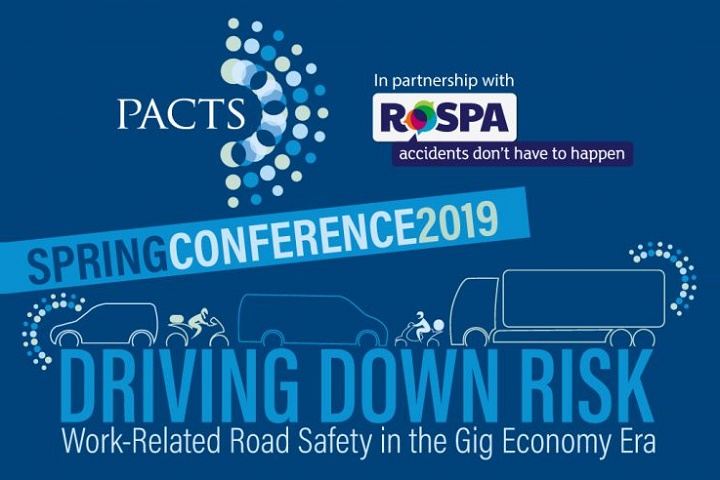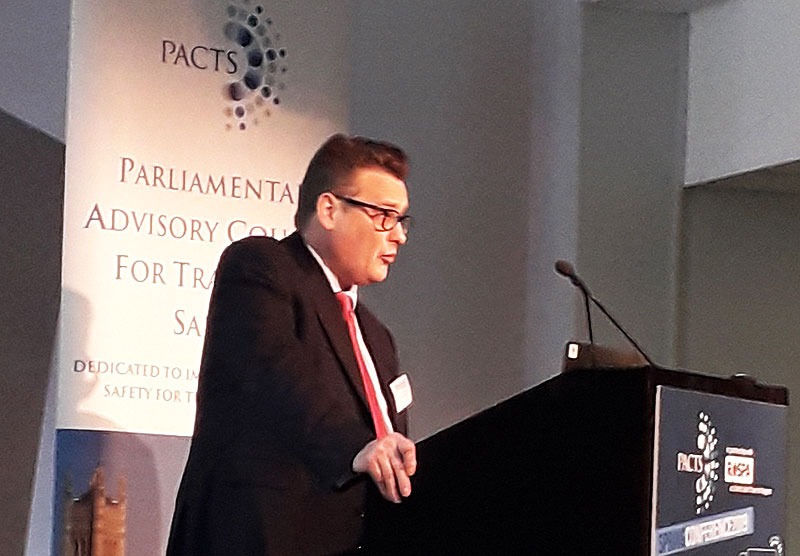
Soundbites from the ‘Driving Down Risk – work-related road safety in the gig economy era’ conference, organised by PACTS, which took place on 28 March.
Took place at the Queen Elizabeth II Centre, London on 28 March
This page does not automatically refresh – click here to read the latest entries.
Introduction
There are around 500 work-related road deaths a year in Great Britain – around 30% of total road deaths. This far exceeds the number of deaths in the workplace reported by the Health & Safety Executive. Employers have responsibilities for the safety of their workforce on the roads.
They also have levers which can be used to deliver safer driving, levers which don’t apply to private road users. There is now new energy to tackle this issue: Highways England’s Driving for Better Business scheme, multi-agency initiatives involving the HSE, DVSA and others, while the Department for Transport is encouraging uptake of safer vehicles.
Telematics technology offers employers new abilities to manage fuel consumption, fleet efficiency and safety. At the same time, the gig economy is presenting new challenges and risks for drivers and riders.
This conference will bring together the key players in this sector, highlighting public policy, good practice, new research and technology and management practice.
Chris Green, Partner, Crime and Regulatory, Keoghs
Presentation: Health and road safety at work – lessons from legal practice
 We’re all here to change behaviour and reduce the number of collisions.
We’re all here to change behaviour and reduce the number of collisions.
But not all work-related deaths are the fault of people driving for work.
Some companies are not adopting the right approach – they should assess the risks of those driving.
Companies can be found guilty under sections 2 and 3 of the Health and Safety at Work Act – example HSE v Midland Red (South) Ltd (parent company Stagecoach).
Judge found company’s failings were a significant cause of the crash.
Steps that can be taken by employers:
• Tighter control on working hours
• More frequent checks for older drivers
• Drivers periodically being observed
• More comprehensive investigation regarding previous complaints
• In-vehicle CCTV – and actually do monitor it from time to time
• Telematics
• Identify when additional training is required
• Review relevant health and safety policies
Barney Thompson, Director, Trakm8
Presentation: The contribution of technology
Trakm8 is a UK-based telematics company which has sold more than 1 million unit to date.
That equates to 15bn miles of data.
Work with automotive (AA, Green Flag), insurance (Churchill, Direct Line), fleet (Scottish Power) and plant.
Devices usually have three components:
• GPS chipset – where the vehicle is
• Accelerometer – how the vehicle is moving
• SIM chip – allows transfer of data
Commonly used in insurance – can detect when a vehicle has been involved in a collision.
Tries to find behaviours that are related to crashes – predicting those who are in danger.
The benefits for fleets:
• Reduce claims frequency
• Assist day-to-day running of their business – eg fuel use
• Crash detection alerts
Irrefutable evidence to protect against false claims and ‘crash for cash’ fraud.
Can detect driver fatigue – and provide alert
We can provide information – but it’s up to individual companies to act.
Panel discussion
Panel 2: The private sector – delivering WRRS in a competitive environment
Participants:
Huw Bevan, UK Head of Safety, Uber (HB)
Dave Conway, Quality & Environmental Manager, FM Conway (DC)
Laurence Atchison, Project Manager, European Transport Safety Council (LA)
Heather Ward, Honorary Senior Research Fellow, University College London (HW)
Question: Is there a place for regulation around potential distractions?
HW: This is how people get their jobs and make their living. Mobile phone usage is illegal, but it’s difficult to stop.
DC: Major concern for our company – so much so that we’ve installed blocker devices to stop mobile phones working while vehicles are moving.
HB: We work with drivers to reduce distractions – such as introducing ‘night mode’ to reduce screen glow. Trying to work on ways to reduce how often drivers have to touch their mobile phones.
HB: Safety is a huge commitment for Uber – we limit how long drivers can operate before having to take a break.
LA: When it comes to mobile phones, some of the best practices we see are through companies creating their own initiatives
Question: Are other countries are taking successful approaches to the issues surrounding gig economy workers?
LA: Issues are same in all countries, but reaction is more mixed. Most effective countries are ones where there is a good working relationship between road safety and health and safety authorities.
Question: If you had magic wand – how would you end the road casualty ‘stagnation’?
LA: A whole host of combined measures. The newly announced vehicle safety standards, a big package of measures. The perfect example of legislation that can have a big impact.
Question: Is the poor pay of people in the gig economy – and the system of paying per job – increasing danger?
HW: Gig economy drivers/riders have to chase the work and that results in them taking risks. Comes back to earning enough money.
HB: Commissioned a study showing drivers earning £11 per hour after costs.
Question: Is the panel concerned about the mental health crisis within the gig economy?
HB: In a general trend, awareness of mental health is rising. Uber is working to provide drivers with mindfulness sessions.
DC: We are very mindful and conscious of this issue in the construction industry.
Heather Ward, Honorary Senior Research Fellow, University College London
Presentation: The management of road risk in the gig economy
What is the gig economy?
• People who do not get paid a salary but get paid per gig or a ‘piece rate’
• Often referred to as lifestyle workers or flex couriers
The workers
• Self-employed and are not covered by employment law
• Very few rights at work
Estimated 4.4% of GB population had done some work in the gig economy in last 12 months – about a quarter live in London & 56% were 18-34 years.
How is safety taken into account? – a study of gig economy workers
• Companies more interested in ‘the life of the parcel than the person delivering it’
• Virtually no training
• No safety equipment given
Fatigue is a ‘huge, huge’ problem. Not just physical, but mental tiredness.
Distraction – many of those on two wheels said they handled their phone while riding to accept ‘jobs’
Riders/drivers get paid more to deliver during dangerous conditions – concerning
Many admitted to speeding and parking illegally due to pressure of delivering on time.
Interviews with managers:
• Acknowledged the intense pressure that couriers were under and the risks they experienced
Those on two wheels more able to self regulate – for example when tired.
Gig economy creates ‘perfect storm’ of risk factors.
Recommendations:
• Couriers should sign up for a time block and be paid for their time
• Mobile phones should not be allowed to cause a distraction
• Companies should not incentivise vulnerable road users to take additional risks
• Safety equipment – such as hi-vis – should be provided
• The health and safety implications of carrying large backpacks on two wheeled vehicles needs to be tested
Jim Fitzpatrick MP, Chair of the Transport Safety All-Party Parliamentary Group
Presentation: Afternoon keynote
 • Road safety statement ‘will be issued soon’ – expected May
• Road safety statement ‘will be issued soon’ – expected May
• Backing re-introduction of casualty reduction targets – hopeful Jesse Norman will do so
• Road safety figures stagnating since 2010 – when targets were removed
• Evidence points towards GDL – and Government are interested in it
• No visible roads policing ‘a huge mistake’ – no fear of being caught
• On work-related deaths – around 500 a year – not sure why we tolerate it
• Progress being made on cycle infrastructure – segregated lanes
• Government committed to extending sentences for dangerous/careless driving
Panel discussion
Panel 1: Protecting the public and employees on the roads
Participants:
Stuart Lovatt, Strategic Road Safety Lead, Highways England (SL)
George Lee, Chief Executive, Highways Term Maintenance Association (GL)
Dave West, Regional SHEQ Coach, Biffa (DW)
Question: How do we enforce compliance and make companies take responsibility?
GL: Companies are seeking to achieve economical advantage by trimming responsibilities
SL: Need businesses to take ownership – don’t give contracts to those who do not comply
SL: We are using technology (including cameras) to detect companies who are non compliant. Trying to increase the fear of detection
DW: A lot of companies want to take that responsibility
Question: Are there ways to incentivise road safety – and push it up the agenda – to provide ‘cut through’ with small businesses?
SL: Highlight the significant benefits – including financial
GL: A front-end investment needs to be made
SL: Help police target businesses who don’t care, not those who make mistakes
Question: How can legislation be enforced when budgets are being cut?
GL: Largely beyond our control
SL: Raise the profile of our work – get media support. Also need to try and find ways to change behaviours.
SL: Need businesses to enforce bigger punishments to those found not being compliant. Fines not enough – the risk of losing a job may change behaviour.
Question: Is there also an issue with the general public endangering road workers?
GL: Needs to be more respect for road workers – 76% of drivers admit to skipping red lights in roadworks. 74% break speed limits designed to keep road workers safe. A major issue.
DW: Road workers need to be treated as normal people – often treated as ‘scum’. A lot of the issues happen on pavements, roadworks etc; places where drivers shouldn’t actually be.
Anne-Marie Penny, Senior Programme Manager, Road User Safety, DfBB programme, Highways England
Presentation: Driving for Better Business explained
Key programme in HE’s road safety work
Not aimed at driver – aimed at employer who has duty of care
We don’t need more legislation – there is plenty which covers this area, including:
• Health and Safety Work Act
• Road Traffic Act 1988
• Road Safety Act 2006
All this means employers and employees have a joint responsibility for their road safety
DfBB
• Aim: to improve awareness of work-related road safety
• Ambtition: To bring about radical change
• Mission: To improve levels of compliance
The challenge
• 86% of fleets have experienced a collision in the last 12 months
Why DfBB?
• Raises awareness
• Has strategic link to other road safety areas (motorcyclists, young drivers)
• Promotes legislation and good practice
• Central hub for related advice
Seven steps to excellence: register, leadership, risk assess, policies, measure, commitment, good practice.
What does DfBB provide?
• A toolbox to check risk
• A commitment to improve work-related road safety
A culture change – not a box ticking exercise
Making it easier for people to do the right thing
Delivering multi-agency initiatives with HSE, police, DVSA etc
Nine pilot events targeting:
• Driver compliance
• Roadworthiness
• Load security
• Towing
• Tyres
The Gig Economy – a difficult area to address
Set up a road risk group, featuring a wide range of partners. Aims to address issues one at a time.
DfBB could be the biggest change to road safety in a generation
Pauline Reeves, Deputy Director – Road Safety, Department for Transport
Presentation: Government support for tackling WRRS and the Driving for Better Business programme (by video)
• The importance of H&S is well established – now employer well-being is becoming as important
• But there is a long way to go in terms of achieving this for driving to work
• There are wide-ranging consequences of mismanagement when it comes to work-related road safety
• The average cost of a fatality is nearly £2m
• Helping employers reduce work related collisions is a key priority
• DfT to publish action plan later this year – embedding a strong culture for work-related road safety
• Looking forward to seeing more businesses sign up for Driving for Better Business – let’s all lead by example
• Better management of work-related road safety is something we all have responsibility for
Mark Winn, Chief Driving Examiner, Driver & Vehicle Standards Agency
 Presentation: Work-related road safety – the DVSA’s approach
Presentation: Work-related road safety – the DVSA’s approach
Our vision:
• Safer drivers
• Safer vehicles
• Safer journeys
‘Helping you through a lifetime of safe driving’ – ‘Helping you keep your vehicle safe to drive’ – ‘Protecting you from unsafe drivers and vehicles’
WRRS – why is it important?
• Without it, new drivers won’t know what to do
What does the DVSA do externally?
• Enforcement
• Vehicle checks
What does the DVSA do internally?
• Role specific – less concern about driving examiners
• Driving/riding assessments and training
• Annual licence checks
‘Weigh bridges’ – a limited number in use, but DVSA would like to make more use of them
Alan Craddock, Head of Transport and Public Services Unit, Health & Safety Executive
Presentation: Work-related road safety – current HSE initiatives
Transport is a big killer in the workplace – 30% of KSIs have a work-related element.
Road transport underpins almost every industry sector in the UK.
Three priorities:
• Load security
• Parcel carriers
• Review our approach to WRRR
Leading indicators – telematics
Should not be used to establish blame, but to:
• Identify trends and improve performance
• Identify training requirements
The Gig Economy
• Risks need to be managed
• Health and safety law still applies
All workers are entitled to work in a safe environment where risks to their health and safety are properly controlled.
Anything transported on the public highway must be secured to protect the driver, other road users, and those involved in unloading.
Why is poor practice happening?
• Risk is not considered or managed properly
• Insufficient training/info
• Time/cost pressures
• Inconsistent enforcement
What are we doing?
• Training for roads policing officers
• Joint operations with police forces, DVSA etc
• Sharing outcomes with industry to help drive improvements and encourage innovation
Safe, efficient transport is achievable & getting it right benefits everyone:
• Fewer delays and disruptions on the road
• Reduced risk of injury or death for road users

Karl Turner MP, Shadow Minister for Road Safety
Karl Turner MP is currently serving as shadow minister for shipping, aviation and road safety, as part of the shadow transport team.
Presentation: Morning Keynote – Labour and Vision Zero
The Government has talked a good game about road safety – but will leave a disappointing and frustrating legacy.
• Progress has well and truly stalled
• More people are killed on the roads while travelling to work, than actually at work
• We seem to have accepted road deaths
• New approach needed – a change in thinking and culture…. Labour would adopt the Vision Zero approach
• Action required to deliver safe speeds, streets, vehicles and behaviours
Speed – reducing speed is fundamental to reducing danger
• Labour would support a review of speed limits – and possibly 20mph for residential streets
Streets– we should take action on high risk areas such as junctions; be proactive, not reactive
Vehicles– push for the safest vehicle standards
Behaviour– improve education, marketing, training
Government– whatever Brexit outcome – will stick rigidly to new EU vehicle standards
Next Labour Government will lead a step change towards Vision Zero






Comment on this story